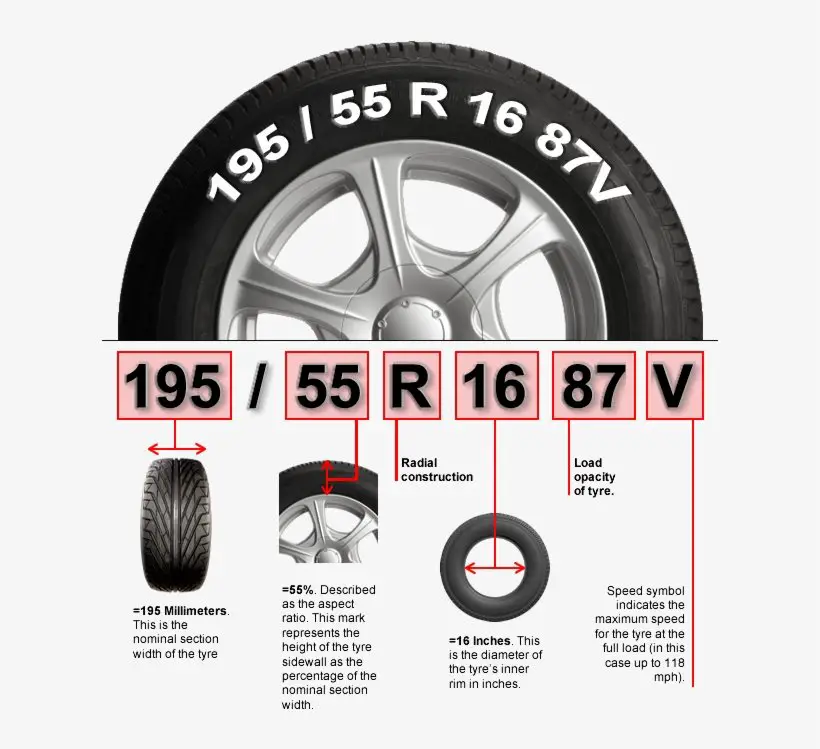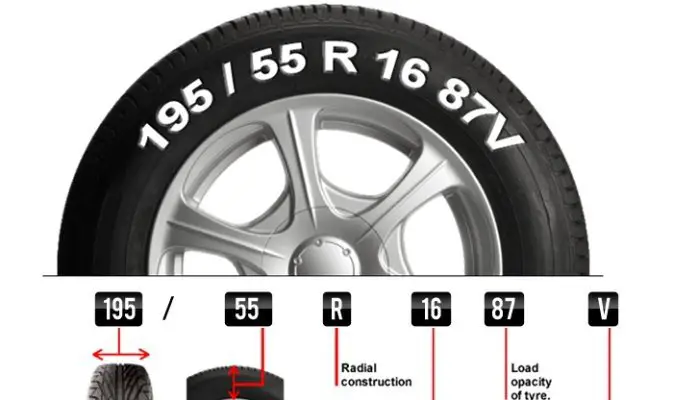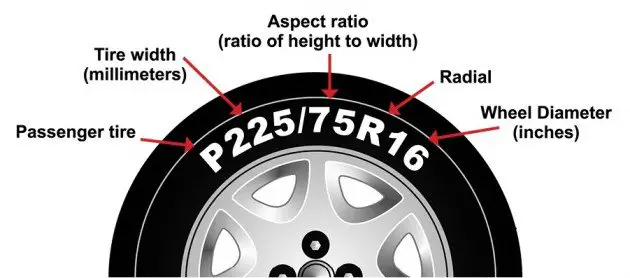Reading The Size Of A Tire
Like most vehicle parts, tires eventually wear out and need replacement. Wear and tear of the treads reduces traction, and aging rubber makes the tires weaker and more susceptible to going flat. Thats why experts recommend replacing your tires every five or six years, even if the treads arent completely worn down.
When the time comes to outfit your car with new tires, its crucial to choose the right ones. Your tires need to be the right size and shape to fit onto your vehicles wheels and inside its wheel wells, with enough room for the suspension to work properly. Maximizing ease of handling also matters. Thats why size is the first important thing to get right. Then theres tire type, speed rating and load index.
Sound confusing? Heres a simple explanation of all important tire information, beginning with size.
Plus, heres how to change a car tire:
Reading Tire Sizes And Ratings
Knowing how to read tire sizes on your cars tires is important, so youll know which tire size to buy the next time your vehicle requires new tires. Reading tire sizes might seem like reading Chinese if you dont know what youre looking at, but its actually pretty easy once you know how to read the tire size information. Each number or letter corresponds with particular information for your car, and this is standard throughout the industry.
Below is a guide for how to read tire sizes. Ill first touch on the tire numbers youll need to learn how to read, then move on to the most common letters youll come across.
What Does Each Symbol Mean
P: The character in front of the code designates the type of tire. Most commonly, a tire will be P, designated for use in passenger vehicles. LT is the second most common tire type, used to represent light trucks. If there is no code, your tire is of European make, and has different load bearing capacities.
215: The first number designates the tires width, from sidewall to sidewall. In this case, the number 215 means that the tire width is 215 millimetres.
65: The number after the dash specifies the tires aspect ratio, which is the ratio of the tires width to its height.
R: The letter R refers to how the tire was created. In this case, R means radial, or that the layers of the tire run across it.
Wheel Diameter: The wheel diameter measurement is the end-to-end length, measured in inches. In this case, the diameter of the wheel is 15 inches.
Your tire typically has many other measurements that run along the wheel, but these are the most important. When you are specifying what type of tire you have to your mechanic, these are the key measurements you are going to need to remember.
If you’re looking to purchase new tires or are looking to have your tires replaced and rotated, book an appointment online, give us a call at 647-361-4449, or shoot us a quick instant message, and we’d be happy to help.
Read Also: How To Cancel Car Insurance Geico
Locate The Tire Section Width
The section width is the number that comes immediately after the service type in a three-digit number. The section width indicates the tires overall width when it is mounted on a properly-sized wheel. It is measured by the widest point of the inner sidewall to the widest part of the outer sidewall. Wider tires will generally give more traction for the vehicle, but can be heavier and cause more fuel consumption.
Step 1: Read the first set of numbers after the letter. It will be three digits and is a measure of your tires width in millimeters.
For example, if the tire size is P215/55R16, the section width of the tire is 215 millimeters.
Us Department Of Transportation Code
 > How To Read Tire Size New” alt=”How To Read Tire Size >> How To Read Tire Size New”>
> How To Read Tire Size New” alt=”How To Read Tire Size >> How To Read Tire Size New”> All tires must have a U.S. Department of Transportation number, which indicates that the tire has passed all minimum DOT standards for sale in the United States. This code represents the manufacturer and the factory where the tire was made, as well as manufacturer-specific coding used for tracking in the case of a recall. The last four numbers give the date of production the first two indicate which of the 52 weeks in a year it was made, and the second two numbers represent the year. For example, 5200 indicates that a tire was manufactured during the 52nd week of the year 2000.
Also Check: How Much Does It Cost To Get A Car Painted
Schedule Excessive Wear On Outer Edges Of Tire Inspection
The most popular service booked by readers of this article is Excessive wear on outer edges of tire Inspection. Once the problem has been diagnosed, you will be provided with an upfront quote for the recommended fix and receive $20.00 off as a credit towards the repair. YourMechanics technicians bring the dealership to you by performing this job at your home or office 7-days a week between 7AM-9PM. We currently cover over 2,000 cities and have 100k+ 5-star reviews… LEARN MORE
Q: I Live In A Place That Sees Regular Snow Can I Just Use All
A: You can, but its not recommended. All-season tires are designed to provide good traction in a wide variety of weather and temperature conditions, not all of them, as the name would suggest. If you live in a place that sees snow on a regular basis, or where temperatures drop and stay below 40 degrees Fahrenheit, winter tires should be on your shopping list.
Don’t Miss: How To Transfer Car Title In Az
Section Width Of Tire
The three digits following the service type prefix tell us the cross-sectional width of the tire in millimeters.
In the example above, the tires width, measured from the widest point of the inner sidewall to the widest point of the outer sidewall when properly mounted, is 225 millimeters. The section width can be converted to inches by dividing the width in millimeters by 25.4 like so: / = 8.86 inches.
What Do The Numbers On Tires Mean
There’s a massive amount of information branded on the sidewall of every tire … but it’s written in code. The tire size is just one small piece of this code. The tire size “P225/45R17 91V” may not mean much to the average person, but to tire geeks like us it speaks volumes. Read on to learn how to crack the tire code with this handy guide dedicated to tire types, sizes, and construction.
Read Also: How Much To Get Car Detailed
Why Do I Need To Know The Size Tire That Comes On My Car
Well, for starters, we assume you want to get the right size tire when you have to pony up the cash? Your local tire shop can look up the tires that came on your car, but what if you bought an options package with a special wheel size? What if the person that owned the car before you put on custom wheels?
How To Read Sidewall Tire Numbers And Markings
The sidewall of your tires is filled with important information that tells you everything you need to know about your tire. The numbers can be a bit overwhelming to the untrained eye, so the best way to understand tire markings is to take an example and break it down, bit by bit.
Below are tips and information to help you learn how to read tire size and other tire markings commonly seen in the U.S.
Also Check: How To Get Internet In Your Car
How Old Are Your Tires
Almost everything you need to know about your tires is molded into the sidewall and coded according to federal requirements, including the specific week and year when a tire was made.
To read the date on a tire, look near the edge of the rim for a series of characters starting with the letters DOT. This is the Department of Transportation code, which indicates that the tire has passed all minimum DOT standards for sale in the United States.
This code can tell you the manufacturer of the tire and the factory where it was made, as well as provide lot-specific information used for tracking in case of a recall.
The last four digits of this code tell you when your tire was manufactured. The first two numbers indicate what week of the year it was made , and the second two numbers represent the year. For example, 5200 would reveal that a tire was manufactured during the 52nd week of the year 2000.
Prior to the year 2000, DOT coding was slightly different. If you have a tire that doesn’t match the coding you see in our example, it was likely manufactured before 2000 and should be retired as a safety precaution.
Standard Golf Cart Tires

No doubt It can be confusing trying to figure out which golf cart tire size you need. For many cart owners, this might be their first new tire purchase. But dont worry, weve got you covered. Many stock golf cart tires clock in at 18 inches tall and 8.5 inches wide when full of air at the proper tire pressure. This type of tire can be fitted on an 8-inch round hub. The two most common stock tire sizes are 8 inches wide and 7 inches wide.
However, these tires can come in other sizes as well, such as:
- 10-inch tires
There are even options to customize your tires depending on your needs or make/model.
Consult a Wheel Finder
If you know the basic information about your golf cart, you can eliminate the guesswork by using an application to find the correct tire size for your golf cart. Information you will generally need includes the following:
- The make of your golf cart
- The model of your golf cart
- The year your golf cart was manufactured
All of this can help you find out which tire is best suited to your golf cart. You can also keep an old tire to use as a reference. Even taking a picture of the tire may be helpful, as long as you get a close up of the tire to show any relevant information.
You May Like: What Year Is My Golf Cart By Serial Number
Panic Stopping: How Much Tread Depth Do You Need
the tools you need to help ensure your tires are right when it matters. * All Tires By * Vehicle * Size * Brand * Category * Wheel Diameter * Tire & Wheel Packages * Winter / Snow Tires By * Vehicle * Size * Brand * Tire & Wheel Packages * Explore More About Tires * Wheels Try a new look for your
How To Read Car Tire Size
Jason Unrau
Before you purchase a new tire for your vehicle, you need to know what size it is along with other specifications, such as tire service type and construction. If you dont purchase a tire designed to work with your car, or one that is not the same size as the other tires, youll have problems with steering and lose efficiency and performance. Use this guide to understand what all of the numbers and letters on the sidewall of your tire mean.
Recommended Reading: When Replacing Car Battery Which Terminal First
Bfgoodrich Brings Sport To The High Performance All
sizes, targeting coupes and sedans with select 14″ – 18″ sizes. Find out how much of the g-Force Super Sport A/S H& V’s “sport” has trickled down to the High Performance All-Season category — watch as we compare the H-speed rated version with three other H-speed rated tires from the category. Read
Find The Right Tires With Tire Rack
Listen, we know how hard it can be to pick the right tire. Between the word-jumble that are tire specifications, as well as the tire manufacturer’s names for tires that never just say what they are, it can be a pain and you might end up with the wrong shoes for your ride. That’s why we’ve partnered up with our friends at Tire Rack. They’ll take the headache out of tire shopping. All you have to do is .
Don’t Miss: How To Remove Scuff Marks From Car Door Panels
Testing Tires Designed To Match Today’s Pickups And Suvs
the tools you need to help ensure your tires are right when it matters. * All Tires By * Vehicle * Size * Brand * Category * Wheel Diameter * Tire & Wheel Packages * Winter / Snow Tires By * Vehicle * Size * Brand * Tire & Wheel Packages * Explore More About Tires * Wheels Try a new look for your
Reading The Letters On Your Tires
- R Radial construction. The tire tread is designed to give it added strength. Found between aspect ratio number and the rim size number.
- B Belted tire construction. The tire tread is designed to give it a smoother ride and bet traction. Found between aspect ratio number and the rim size number.
- D Bias-ply tire construction. Designed to give a smoother ride on rougher terrain, though the trade off is weaker plies and therefore weaker treads. Found between aspect ratio number and the rim size number.
- M + S Mud and Snow. Means the tire is designed to ride on mud and snow without trouble. Usually found before the numbers.
- P Passenger. This tire is made for passenger vehicles. Usually found before the numbers.
Read Also: How To Upgrade Car Interior
Determine The Service Type
The service type tells you what type of vehicle the tire is manufactured for. For example, some tires are designed for passenger cars, while others are designed for larger trucks. The service type is indicated by the preceding letter on the tire size and is marked on the tires sidewall.
While the service type isnt a measurement, it does help with finding the correct tire size for your car. There are differences that are tied to service type, such as the tread depth and how many plies are used to manufacture the tire, but these numbers arent used in determining the overall tire size.
Step 1: Locate the group of numbers on the side of your tire. The group of numbers is the tire size, indicated in a format such as P215/55R16.
Step 2: Determine the preceding letter on the tire size. In this example, the P is the service type indicator.
The letter tells you what category of vehicle the tire is designed for. Here are the possible letters that you will see for the tire service type:
- P is for a passenger car
- C is for a commercial vehicle
- LT is for light truck
-
T is for a temporary tire or spare tire
-
Note: Some tires dont come with a service type letter. If there isnt a service type letter, this indicates that the tire is Metric size. You will most typically see this type of tire for European cars.
Tire Size Explained: What The Numbers Mean

Tire size can be confusing. Some numbers on the sidewall are listed in millimeters while others are inches. Plus, the right size for your car, truck, or trailer can differ depending on where and how you drive.
You can see your original equipment tire size in your owners manual or on the placard generally located on the drivers side door jam. This is the sizing recommended by the vehicle manufacturer.
If youre interested in switching out your tires for a different look or performance, a good place to start is the numbers and other indicators on your existing tires sidewall. Next, have a tire professional help you determine a tire size range that will fit your vehicle and driving needs.
Don’t Miss: How To Protect Car From Hail
Q: Does My Tire Size Really Matter
A: Does the sizing of the only part of your vehicle designed to actually touch the road matter? Lets be realistic, here. Your tire sizes absolutely matter. You might be able to get away with a slightly different size, such as one that offers a larger sidewall, but only to a small degree. If you want or need a different size tire youll need to get different wheels and do some math to calculate the right size.
How To Read A Tire
This article was co-authored by Rocco Lovetere. Rocco Lovetere is a Master Mechanic at Rocco’s Mobile Auto Repair in California, which he owns with his family. He is an ASE Certified Automotive technician and has worked in automotive repair since 1999. This article has been viewed 41,242 times.
Knowing how to read a tire can give you important information about the type of tire on your car, RV, trailer, or motorcycle. This can be useful when buying replacements for your vehicle, considering tire upgrades, or changing to seasonal tires if you live where winter weather can be an issue. By knowing how to interpret the numbers and letters on a car tire, you can know the speed rating, temperature resistance, load index numbers, as well as the tire’s width and rim diameter.
Also Check: How Much Horsepower Does My Car Have
How To Read Speed Rating Load Index & Service Descriptions
technology to ensure our site is secure Norton Security Services. * 0 Share on Facebook Share on Twitter Share on Pinterest Email Page to a Friend HowtoRead Speed Rating, Load Index & Service Descriptions Using a P195/60R15 87S tire size as our example, the 87S at the end of the size
